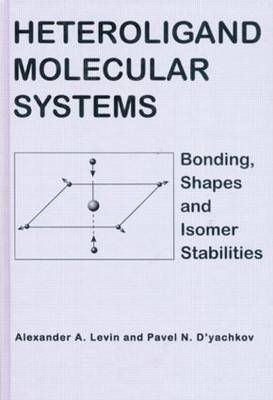
Heteroligand Molecular Systems
Taylor & Francis Ltd (Verlag)
978-0-415-27235-3 (ISBN)
- Titel ist leider vergriffen;
keine Neuauflage - Artikel merken
Heteroligand molecular systems with extremely varied properties are widespread in inorganic, co-ordination, and organometallic chemistry, areas that are developing rapidly and have a wide range of practical applications. Heteroligand Molecular Systems: Bonding, Shapes and Isomer Stabilities summarizes and analyzes the wealth of data concerning the structure, isomerism, and isomerization of heteroligand systems that has been accumulated over recent years.
The first two chapters introduce quantum chemistry and the applications of perturbation theory to chemical problems. This theoretical basis is then used in the remaining chapters, where perturbation theory methods are used to describe a wide range of problems related to the mutual influences of ligands and relative isomer stabilities in a variety of heteroligand molecules and complexes of nontransition elements and transition metals.
Heteroligand Molecular Systems: Bonding, Shapes and Isomer Stabilities continues to provide a sound foundation for advanced students, professors, and researchers involved with molecular structure, and coordination, inorganic, and organometallic chemistry.
The Electronic Structure of Molecules
Total and Electronic Hamiltonians
Electronic Hamiltonian and Electronic Terms
Molecular Orbitals and the MO LCAO Method
The Electronic Structure of High-symmetry Molecules and Complexes
Molecular terms in the MO Method
Perturbation Theory and Adiabatic Potential
Perturbation Theory for Energies and Wave Functions
Vibronic Coupling as Perturbation
Replacement of Atoms as Perturbation: Substitution Operator
Adiabatic Potentials of Heteroligand Systems
Mutual Influence of Ligands and Relative Isomer Stability in s-Bonded Quasi-Octahedral Complexes
Mutual Influence of Ligands and Isomer Stability: A Short History
Transition Metal Complexes: Bond Lengths
14-Electron Nontransition Element Complexes: Bond Lengths
12-Electron Nontransition Element Complexes: Bond Lengths
The Nature of Mutual Influence of Ligands
Mutual Influence of Ligands in the Basis of all s-MOs
Bond Angles in Heteroligand Complexes
Isomers of Transition Metal d0 and d6 Complexes
Isomers of Nontransition Element Complexes
Mutual Influence of Ligands and Relative Isomer Stability in s-Bonded Quasi-Square-Planar and Quasi-Tetrahedral Complexes
Planar Transition Metal Complexes: Bond Lengths
Planar Complexes of Nontransition Elements: Bond Lengths
Isomers of Planar Transition Metal ML2X2 Complexes
Isomers of Planar Transition Metal ML2XY Complexes
Thermal Isomerization of Magnus Salt-Type Compounds
Planar Transition Metal d9 Complexes
Quasi-Tetrahedral Molecules and Complexes
Quasi-Octahedral CuIIL6-k Xk d9 Complexes
Homoligand d9 Complexes: E-e Problem
Linear E-e-S Problem
Linear E-e-S Problem: Stability of Cis and Trans Isomers
Quadratic E-e-S Problem
Distortion Isomers of Chain CuII(NH3)2Hal2 Complexes
Distortion Isomers of Cis-CuII L4X2 Complexes
Mutual Influence of Ligands and Isomerism in Quasi-Octohedral Complexes with Multiply Bonded Substituents
Influence of Multiply Bonded Ligand: Bond Lengths
Multiply Bonded Ligand: Bond Angles
Stability of Cis and Trans Isomers for Transition Metal Complexes with Multiply Bonded Substituents
Mutual Influence of Ligands and Isomers in Actinide Complexes
Isomers of Heteroligand Bipyramidal Molecules
Stability of Isomers in First-Order Perturbation Theory
Isomers of 10-Electron Trigonal-Bipyramidal Molecules
Order-Disorder Ferroelectrics with Intermolecular H-Bonds
Rearrangement of H-Bond Protons as Cooperative Substitution of Ligands
Molecular Geometry in the Ferroelectric Phase
Ising Model Interaction Parameters and Slater Parameters
Concluding Remarks
References
Compound Index
Subject Index
| Erscheint lt. Verlag | 27.9.2001 |
|---|---|
| Verlagsort | London |
| Sprache | englisch |
| Maße | 156 x 235 mm |
| Gewicht | 549 g |
| Themenwelt | Naturwissenschaften ► Chemie ► Anorganische Chemie |
| Naturwissenschaften ► Chemie ► Organische Chemie | |
| Naturwissenschaften ► Chemie ► Physikalische Chemie | |
| ISBN-10 | 0-415-27235-1 / 0415272351 |
| ISBN-13 | 978-0-415-27235-3 / 9780415272353 |
| Zustand | Neuware |
| Haben Sie eine Frage zum Produkt? |
aus dem Bereich


